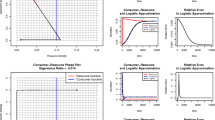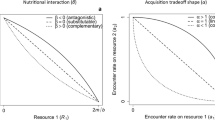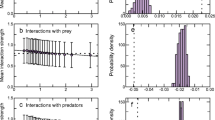Abstract
Finding the conditions that ensure the survival of species has occupied ecologists for decades. Theoretically, for mechanistic models such as MacArthur’s consumer-resource model, most of the efforts have concentrated on proving the stability of an equilibrium assuming that it is feasible, but overlooking the conditions that ensure its feasibility. Here, we address this gap by finding the range of conditions that lead to a feasible equilibrium of MacArthur’s consumer-resource model, where species competition is mediated by their consumption of similar resources, and study how changes in the system’s structural and parametric properties affect those ranges for communities of any size. We characterize the relationship between the loss of feasibility and the increase in complexity (measured by the system’s richness and connectance) by a power law that can be extended to random competition matrices. Focusing on the pool of consumers, we find that while the feasibility of the entire system decreases with the size of the pool, the expected fraction of feasible consumers increases—safety in consumer numbers. Focusing on the pool of resources, we find that if resources grow linearly, the larger the pool of resources, the lower the feasibility of the system and the expected fraction of feasible consumers—danger in resource numbers. However, if resources grow logistically, this pattern is reversed with a sublinear increase in feasibility, as it has been previously reported in experimental work. This work provides testable predictions for consumer-resource systems and is a gateway to exploring feasibility in other mechanistic models.





Similar content being viewed by others
Data availability
Empirical data were not used for this research.
Code availability
The code for this work is provided and will remain available via the following link: https://github.com/andrea-aparicio/FeasibilityCRM.
References
Allesina S, Tang S (2012) Stability criteria for complex ecosystems. Nature 483(7388):205–208
Almeida-Neto M, Guimaraes P, Guimaraes PR Jr, Loyola RD, Ulrich W (2008) A consistent metric for nestedness analysis in ecological systems: reconciling concept and measurement. Oikos 117(8):1227–1239
Bagchi S, Ritchie ME (2012) Body size and species coexistence in consumer-resource interactions: a comparison of two alternative theoretical frameworks. Theor Ecol 5:141–151
Bastolla U, Fortuna MA, Pascual-García A, Ferrera A, Luque B, Bascompte J (2009) The architecture of mutualistic networks minimizes competition and increases biodiversity. Nature 458(7241):1018–1020
Butler S, O’Dwyer JP (2018) Stability criteria for complex microbial communities. Nat Commun 9(1):1–10
Case TJ, Casten RG (1979) Global stability and multiple domains of attraction in ecological systems. Am Nat 113(5):705–714
Chesson P (1990) MacArthur’s consumer-resource model. Theor Popul Biol 37(1):26–38
Chesson P (2000) Mechanisms of maintenance of species diversity. Annu Rev Ecol Syst pp. 343–366
Dal Bello M, Lee H, Goyal A, Gore J (2021) Resource-diversity relationships in bacterial communities reflect the network structure of microbial metabolism. Nat Ecol Evol 5(10):1424–1434
Deng J, Angulo MT, Saavedra S (2021) Generalizing game-changing species across microbial communities. ISME Commun 1(1):22
Dougoud M, Vinckenbosch L, Rohr RP, Bersier LF, Mazza C (2018) The feasibility of equilibria in large ecosystems: a primary but neglected concept in the complexity-stability debate. PLoS Comput Biol 14(2)
Gardner MR, Ashby WR (1970) Connectance of large dynamic (cybernetic) systems: critical values for stability. Nature 228(5273):784–784
Gibbs T, Zhang Y, Miller ZR, O’Dwyer JP (2022) Stability criteria for the consumption and exchange of essential resources. PLoS Comput Biol 18(9)
Goh BS (1977) Global stability in many-species systems. Am Nat 111(977):135–143
Gourion D, Seeger A (2010) Deterministic and stochastic methods for computing volumetric moduli of convex cones. Comput Appl Math 29:215–246
Grilli J, Adorisio M, Suweis S, Barabás G, Banavar JR, Allesina S, Maritan A (2017) Feasibility and coexistence of large ecological communities. Nat Commun 8(1):1–8
Haygood R (2002) Coexistence in MacArthur-style consumer-resource models. Theor Popul Biol 61(2):215–223
Holling CS (1973) Resilience and stability of ecological systems. Annu Rev Ecol Syst pp. 1–23
Hutchinson C (1957) Concluding remarks, coldspring harbor symposium. Quant Biol 22:415–427 vkerner1957statistical Kerner EH, (1957) A statistical mechanics of interacting biological species. Bull Math Biophys 19(2):121–146
Kerner EH (1957) A statistical mechanics of interacting biological species. Bull Math Biophys 19(2):121–146
Lafferty KD, DeLeo G, Briggs CJ, Dobson AP, Gross T, Kuris AM (2015) A general consumer-resource population model. Science 349(6250):854–857
Landi P, Minoarivelo HO, Brännström Å, Hui C, Dieckmann U (2018) Complexity and stability of adaptive ecological networks: a survey of the theory in community ecology. Systems analysis approach for complex global challenges, Springer pp. 209–248
Liu X, Constable GW, Pitchford JW (2023) Feasibility and stability in large Lotka Volterra systems with interaction structure. Phys Rev E 107(5)
Logofet DO (2018) Matrices and graphs: stability problems in mathematical ecology. CRC Press
Lu RP, Smith EP, Good I (1989) Multivariate measures of similarity and niche overlap. Theor Popul Biol 35(1):1–21
MacArthur R (1969) Species packing, and what competition minimizes. Proc Natl Acad Sci 64(4):1369–1371
MacArthur R (1970) Species packing and competitive equilibrium for many species. Theor Popul Biol 1(1):1–11
Marsland R III, Cui W, Mehta P (2020) The minimum environmental perturbation principle: a new perspective on niche theory. Am Nat 196(3):291–305
May RM (1972) Will a large complex system be stable? Nature 238(5364):413–414
Murdoch WW, Briggs CJ, Nisbet RM (2013) Consumer-resource dynamics (mpb-36). Princeton University Press
Roberts A (1974) The stability of a feasible random ecosystem. Nature 251(5476):607–608
Rohr RP, Saavedra S, Bascompte J (2014) On the structural stability of mutualistic systems. Science 345(6195):1253497
Saavedra S, Rohr RP, Fortuna MA, Selva N, Bascompte J (2016) Seasonal species interactions minimize the impact of species turnover on the likelihood of community persistence. Ecology 97(4):865–873
Saavedra S, Rohr RP, Bascompte J, Godoy O, Kraft NJ, Levine JM (2017) A structural approach for understanding multispecies coexistence. Ecol Monogr 87(3):470–486
Saavedra S, Arroyo JI, Marquet P, Kempes C (2023) Linking metabolic scaling and coexistence theories. bioRxiv pp. 2023–02
Saavedra S, Medeiros LP, AlAdwani M (2020) Structural forecasting of species persistence under changing environments. Ecol Lett 23(10):1511–1521
Song C, Saavedra S (2018) Will a small randomly assembled community be feasible and stable? Ecology 99(3):743–751
Song C, Rohr RP, Saavedra S (2017) Why are some plant-pollinator networks more nested than others? J Anim Ecol 86(6):1417–1424. https://doi.org/10.1111/1365-2656.12749
Song C, Rohr RP, Saavedra S (2018) A guideline to study the feasibility domain of multi-trophic and changing ecological communities. J Theor Biol 450:30–36
Takeuchi Y, Adachi N (1980) The existence of globally stable equilibria of ecosystems of the generalized Volterra type. J Math Biol 10(4):401–415
Takeuchi Y, Adachi N, Tokumaru H (1978) The stability of generalized Volterra equations. J Math Anal Appl 62(3):453–473
Tuljapurkar S, Semura J (1975) Stability of Lotka-Volterra systems. Nature 257(5525):388–389
Ulrich W, Almeida-Neto M, Gotelli NJ (2009) A consumer’s guide to nestedness analysis. Oikos 118(1):3–17
Wang P, Wang L (2022) Dynamics of a stochastic consumer-resource model with time-dependent delays and harvesting terms. IAENG Int J Appl Math 52(1):1–6
Funding
Y.Y.L. acknowledges the funding support from National Institutes of Health (R01AI141529, R01HD093761, RF1AG067744, UH3OD023268, U19AI095219, and U01HL089856). A.A. acknowledges the support from National Institutes of Health (T32HL742742).
Author information
Authors and Affiliations
Contributions
A.A. and Y.Y.L. conceived and designed the project; A.A. did the simulations; all authors analyzed and interpreted the data; A.A. wrote the manuscript with the help of T.W.; all authors revised the manuscript.
Corresponding author
Ethics declarations
Ethics approval
Not applicable
Consent to participate
Not applicable
Consent for publication
Not applicable
Conflict of interest
The authors declare no competing interests.
Supplementary information
Below is the link to the electronic supplementary material.
Rights and permissions
Springer Nature or its licensor (e.g. a society or other partner) holds exclusive rights to this article under a publishing agreement with the author(s) or other rightsholder(s); author self-archiving of the accepted manuscript version of this article is solely governed by the terms of such publishing agreement and applicable law.
About this article
Cite this article
Aparicio, A., Wang, T., Saavedra, S. et al. Feasibility in MacArthur’s consumer-resource model. Theor Ecol 16, 225–238 (2023). https://doi.org/10.1007/s12080-023-00566-0
Received:
Accepted:
Published:
Issue Date:
DOI: https://doi.org/10.1007/s12080-023-00566-0




